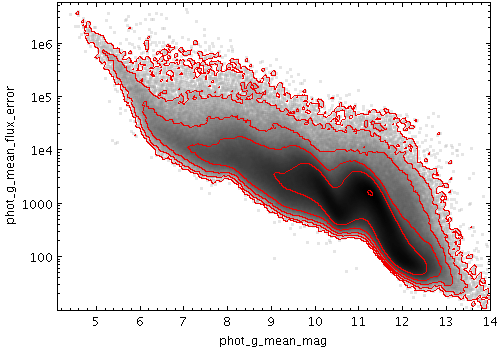
contour
Plots position density contours. This provides another way (alongside the auto, density and weighted shading modes) to visualise the characteristics of overdense regions in a crowded plot. It's not very useful if you just have a few points.
A weighting may optionally be applied to the quantity
being contoured.
To do this, provide a non-blank value for the
weight
coordinate, and use the
combine
parameter to define how the weights are combined
(sum,
mean, etc).
The contours are currently drawn as pixels rather than lines so they don't look very beautiful in exported vector output formats (PDF, PostScript). This may be improved in the future.
Usage Overview:
layerN=contour colorN=<rrggbb>|red|blue|...
combineN=sum|mean|median|stdev|min|max|count
nlevelN=<int-value> smoothN=<pixels> thickN=<pixels>
scalingN=linear|log|equal zeroN=<number> <pos-coord-paramsN>
weightN=<num-expr> inN=<table> ifmtN=<in-format>
istreamN=true|false icmdN=<cmds>
All the parameters listed here
affect only the relevant layer,
identified by the suffix
N.
<pos-coord-paramsN>
give a position for each row of the input table.
Their form depends on the plot geometry,
i.e. which plotting command is used.
For a plane plot (plot2plane)
the parameters would be
xN and yN.
The coordinate parameter values are in all cases strings
interpreted as numeric expressions based on column names.
These can be column names, fixed values or algebraic
expressions as described in Section 10.
Example:

stilts plot2plane in=tgas_source.fits x=phot_g_mean_mag y=phot_g_mean_flux_error
yscale=log xmax=14 ymin=10
layer1=mark shading1=density densemap1=greyscale
layer2=contour scaling2=log nlevel=6
colorN = <rrggbb>|red|blue|... (Color)
The standard plotting colour names are
red, blue, green, grey, magenta, cyan, orange, pink, yellow, black, light_grey, white.
However, many other common colour names (too many to list here)
are also understood.
The list currently contains those colour names understood
by most web browsers,
from AliceBlue to YellowGreen,
listed e.g. in the
Extended color keywords section of
the CSS3 standard.
Alternatively, a six-digit hexadecimal number RRGGBB
may be supplied,
optionally prefixed by "#" or "0x",
giving red, green and blue intensities,
e.g. "ff00ff", "#ff00ff"
or "0xff00ff" for magenta.
[Default: red]
combineN = sum|mean|median|stdev|min|max|count (Combiner)
mean which traces the
mean values of a quantity and
sum which traces the
weighted sum.
Other values such as
median
are of dubious validity because of the way that the
smoothing is done.
This value is ignored if the weighting coordinate
weight
is not set.
The available options are:
sum: the sum of all the combined values per binmean: the mean of the combined valuesmedian: the medianstdev: the sample standard deviation of the combined valuesmin: the minimum of all the combined valuesmax: the maximum of all the combined valuescount: the number of non-blank values per bin (weight is ignored)[Default: sum]
icmdN = <cmds> (ProcessingStep[])
inN.
The value of this parameter is one or more of the filter
commands described in Section 6.1.
If more than one is given, they must be separated by
semicolon characters (";").
This parameter can be repeated multiple times on the same
command line to build up a list of processing steps.
The sequence of commands given in this way
defines the processing pipeline which is performed on the table.
Commands may alternatively be supplied in an external file,
by using the indirection character '@'.
Thus a value of "@filename"
causes the file filename to be read for a list
of filter commands to execute. The commands in the file
may be separated by newline characters and/or semicolons,
and lines which are blank or which start with a
'#' character are ignored.
A backslash character '\' at the end of a line
joins it with the following line.
ifmtN = <in-format> (String)
inN.
The known formats are listed in Section 5.1.1.
This flag can be used if you know what format your
table is in.
If it has the special value
(auto) (the default),
then an attempt will be
made to detect the format of the table automatically.
This cannot always be done correctly however, in which case
the program will exit with an error explaining which
formats were attempted.
This parameter is ignored for scheme-specified tables.
[Default: (auto)]
inN = <table> (StarTable)
-",
meaning standard input.
In this case the input format must be given explicitly
using the ifmtN
parameter.
Note that not all formats can be streamed in this way.:<scheme-name>:<scheme-args>.<" character at the start,
or a "|" character at the end
("<syscmd" or
"syscmd|").
This executes the given pipeline and reads from its
standard output.
This will probably only work on unix-like systems.istreamN = true|false (Boolean)
inN parameter
will be read as a stream.
It is necessary to give the
ifmtN parameter
in this case.
Depending on the required operations and processing mode,
this may cause the read to fail (sometimes it is necessary
to read the table more than once).
It is not normally necessary to set this flag;
in most cases the data will be streamed automatically
if that is the best thing to do.
However it can sometimes result in less resource usage when
processing large files in certain formats (such as VOTable).
This parameter is ignored for scheme-specified tables.
[Default: false]
nlevelN = <int-value> (Integer)
[Default: 5]
scalingN = linear|log|equal (LevelMode)
The available options are:
linear: levels are equally spacedlog: level logarithms are equally spacedequal: levels are spaced to provide equal-area inter-contour regions[Default: linear]
smoothN = <pixels> (Integer)
[Default: 5]
thickN = <pixels> (Integer)
[Default: 1]
weightN = <num-expr> (String)
The value is a numeric algebraic expression based on column names as described in Section 10.
zeroN = <number> (Double)
[Default: 1]